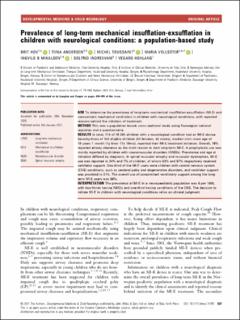Prevalence of long-term mechanical insufflation-exsufflation in children with neurological conditions: a population-based study
Hov, Brit; Andersen, Tiina Maarit; Toussaint, Michel; Vollsæter, Maria; Mikalsen, Ingvild Bruun; Indrekvam, Solfrid; Hovland, Vegard
Journal article, Peer reviewed
Published version

Åpne
Permanent lenke
https://hdl.handle.net/11250/2833306Utgivelsesdato
2021Metadata
Vis full innførselSamlinger
- Department of Clinical Science [2293]
- Registrations from Cristin [9487]
Sammendrag
Aim: To determine the prevalence of long-term mechanical insufflation-exsufflation (MI-E) and concomitant mechanical ventilation in children with neurological conditions, with reported reasons behind the initiation of treatment.
Method: This was a population-based, cross-sectional study using Norwegian national registries and a questionnaire.
Results: In total, 114 of 19 264 children with a neurological condition had an MI-E device. Seventy-three of 103 eligible children (31 females, 42 males), median (min–max) age of 10 years 1 month (1y 5mo–17y 10mo), reported their MI-E treatment initiation. Overall, 76% reported airway clearance as the main reason to start long-term MI-E. A prophylactic use was mainly reported by children with neuromuscular disorders (NMDs). Prevalence and age at initiation differed by diagnosis. In spinal muscular atrophy and muscular dystrophies, MI-E use was reported in 34% and 7% of children, of whom 83% and 57% respectively received ventilator support. One-third of the MI-E users were children with central nervous system (CNS) conditions, such as cerebral palsy and degenerative disorders, and ventilator support was provided in 31%. The overall use of concomitant ventilatory support among the long-term MI-E users was 56%.
Interpretation: The prevalence of MI-E in a neuropaediatric population was 6 per 1000, with two-thirds having NMDs and one-third having conditions of the CNS. The decision to initiate MI-E in children with neurological conditions relies on clinical judgment.
